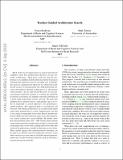Teacher Guided Architecture Search
Author(s)
Bashivan, Pouya; Tensen, Mark; Dicarlo, James
DownloadSubmitted version (6.207Mb)
Open Access Policy
Open Access Policy
Creative Commons Attribution-Noncommercial-Share Alike
Terms of use
Metadata
Show full item recordAbstract
© 2019 IEEE. Much of the recent improvement in neural networks for computer vision has resulted from discovery of new networks architectures. Most prior work has used the performance of candidate models following limited training to automatically guide the search in a feasible way. Could further gains in computational efficiency be achieved by guiding the search via measurements of a high performing network with unknown detailed architecture (e.g. the primate visual system)? As one step toward this goal, we use representational similarity analysis to evaluate the similarity of internal activations of candidate networks with those of a (fixed, high performing) teacher network. We show that adopting this evaluation metric could produce up to an order of magnitude in search efficiency over performance-guided methods. Our approach finds a convolutional cell structure with similar performance as was previously found using other methods but at a total computational cost that is two orders of magnitude lower than Neural Architecture Search (NAS) and more than four times lower than progressive neural architecture search (PNAS). We further show that measurements from only ∼300 neurons from primate visual system provides enough signal to find a network with an Imagenet top-1 error that is significantly lower than that achieved by performance-guided architecture search alone. These results suggest that representational matching can be used to accelerate network architecture search in cases where one has access to some or all of the internal representations of a teacher network of interest, such as the brain's sensory processing networks.
Date issued
2019Department
Massachusetts Institute of Technology. Department of Brain and Cognitive Sciences; McGovern Institute for Brain Research at MITJournal
Proceedings of the IEEE International Conference on Computer Vision
Publisher
IEEE